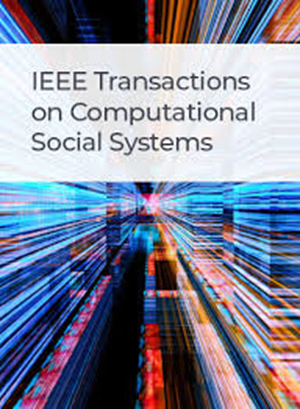Anomaly Detection on Attributed Networks via Multiview and Multiscale Contrastive Learning
IF 4.5
2区 计算机科学
Q1 COMPUTER SCIENCE, CYBERNETICS
IEEE Transactions on Computational Social Systems
Pub Date : 2024-12-17
DOI:10.1109/TCSS.2024.3514148
引用次数: 0
Abstract
Detecting abnormal nodes from attributed networks plays an important role in various applications, including cybersecurity, finance, and social networks. Most existing methods focus on learning different scales of graphs or using augmented data to improve the quality of feature representation. However, the performance is limited due to two critical problems. First, the high sensitivity of attributed networks makes it uncontrollable and uncertain to use conventional methods for data augmentation, leading to limited improvement in representation and generalization capabilities. Second, under the unsupervised paradigm, anomalous nodes mixed in the training data may interfere with the learning of normal patterns and weaken the discrimination ability. In this work, we propose a novel multiview and multiscale contrastive learning framework to address these two issues. Specifically, a network augmentation method based on parameter perturbation is introduced to generate augmented views for both node–node and node–subgraph level contrast branches. Then, cross-view graph contrastive learning is employed to improve the representation without the need for augmented data. We also provide a cycle training strategy where normal samples detected in the former step are collected for an additional training step. In this way, the ability to learn normal patterns is enhanced. Extensive experiments on six benchmark datasets demonstrate that our method outperforms the existing state-of-the-art baselines.基于多视角和多尺度对比学习的属性网络异常检测
从属性网络中检测异常节点在网络安全、金融、社交网络等应用中发挥着重要作用。大多数现有的方法都集中在学习不同尺度的图或使用增强数据来提高特征表示的质量。然而,由于两个关键问题,性能受到限制。首先,属性网络的高灵敏度使得使用传统方法进行数据增强具有不可控和不确定性,导致表征和泛化能力的提高有限。其次,在无监督范式下,混杂在训练数据中的异常节点可能会干扰正常模式的学习,削弱识别能力。在这项工作中,我们提出了一个新的多视角和多尺度对比学习框架来解决这两个问题。具体来说,提出了一种基于参数摄动的网络增强方法来生成节点-节点级和节点-子图级对比分支的增强视图。然后,在不需要增强数据的情况下,采用交叉视图对比学习来改进表示。我们还提供了一个循环训练策略,在前一步中检测到的正常样本被收集用于额外的训练步骤。通过这种方式,学习正常模式的能力得到了增强。在六个基准数据集上进行的大量实验表明,我们的方法优于现有的最先进的基线。
本文章由计算机程序翻译,如有差异,请以英文原文为准。
求助全文
约1分钟内获得全文
求助全文
来源期刊

IEEE Transactions on Computational Social Systems
Social Sciences-Social Sciences (miscellaneous)
CiteScore
10.00
自引率
20.00%
发文量
316
期刊介绍:
IEEE Transactions on Computational Social Systems focuses on such topics as modeling, simulation, analysis and understanding of social systems from the quantitative and/or computational perspective. "Systems" include man-man, man-machine and machine-machine organizations and adversarial situations as well as social media structures and their dynamics. More specifically, the proposed transactions publishes articles on modeling the dynamics of social systems, methodologies for incorporating and representing socio-cultural and behavioral aspects in computational modeling, analysis of social system behavior and structure, and paradigms for social systems modeling and simulation. The journal also features articles on social network dynamics, social intelligence and cognition, social systems design and architectures, socio-cultural modeling and representation, and computational behavior modeling, and their applications.
 求助内容:
求助内容: 应助结果提醒方式:
应助结果提醒方式:


